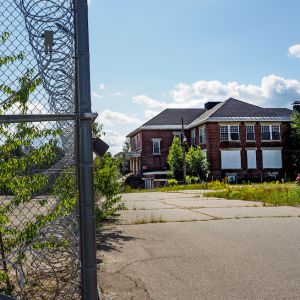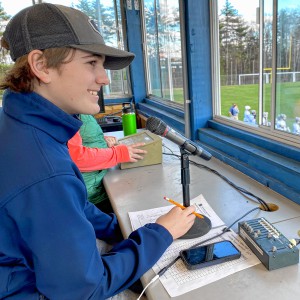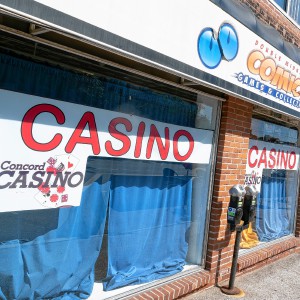Concord celebrates clean energy from a hydropower neighbor
| Published: 06-22-2022 1:48 PM |
Operators of hydropower dams face plenty of complications, including the wrong sort of bubbles, too many American eels and super-cooled “frazil ice,” but one thing that the owner of the Penacook Lower Falls dam doesn’t have to worry about now is fluctuating income.
“It’s nice to have a predictable rate” for electricity, said Madeleine Mineau, Chief Operating Officer of Essex Hydro, the company that owns the 39-year-old dam on the Contoocook River on the border of Concord and Boscawen. “It’s so much better than having the rate change from hour to hour.”
Mineau led city officials on a tour of the 4.6-megawatt dam Tuesday to mark the beginning of the new arrangement with Concord, which as of June 1 is buying enough electricity produced by the dam to cover virtually all the usage by city facilities. The contract, made possible by a new state law that expands the allowable size for what is known as net-metered municipal facilities, is part of Concord’s drive to reduce its contribution to climate change.
The city will buy electricity at a rate that is set by regulators every six months. Previously Essex Hydro sold the power into the wholesale market, where per-kilowatt payment rates change every hour and can occasionally become negative, meaning the dam has to pay to produce electricity.
“The energy and environment committee has really pushed the city to make this happen,” said Mayor Jim Bouley, who touted the jobs involved in local energy as well as the roughly $100,000 a year that the city will get in clean energy credits paid by Unitil, the region’s electric utility. The contract covers 9 million kilowatt-hours of usage a year, about 98% of the city government’s annual needs, including electricity used by the two biggest power users, the water and wastewater treatment plants.
Bill Heinz began working at the Penacook Lower Falls dam when it opened in 1983, shortly after he graduated from high school. He says it replaced an older dam that once powered a mill owned by now-defunct Allied Leather.
Essex Hydro owns three dams on a short stretch of the Contoocook River and all are run-of-river dams, meaning they don’t hold back water to control power generation but depend on the ebb and flow of the river. While this makes them less of an environmental problem, it means that there are times in summer when the river gets so low that they cannot produce power – not good for the bottom line but, Mineau noted, a great time to do maintenance.
Tuesday’s tour went deep into the bowels of the Penacook Lower Falls dam where water is channeled to spin a generator at up to 600 revolutions per minute, sending electricity to a substation on the Concord side of the river. It got loud in there – earplugs were handed out to visitors – but even though it is below water level, it never gets chilly, even in winter.
Article continues after...
Yesterday's Most Read Articles
 No deal. Laconia buyer misses deadline, state is out $21.5 million.
No deal. Laconia buyer misses deadline, state is out $21.5 million.
 “It’s beautiful” – Eight people experiencing homelessness to move into Pleasant Street apartments
“It’s beautiful” – Eight people experiencing homelessness to move into Pleasant Street apartments
 With Concord down to one movie theater, is there a future to cinema-going?
With Concord down to one movie theater, is there a future to cinema-going?
 Quickly extinguished fire leaves Concord man in critical condition
Quickly extinguished fire leaves Concord man in critical condition
 Concord police ask for help in identifying person of interest in incidents of cars being keyed during Republican Party event
Concord police ask for help in identifying person of interest in incidents of cars being keyed during Republican Party event
“Cold? Not at all, with all the excess heat from generation,” said plant electrician Dan Nudd, shouting over the noise.
Winter does produce problems for the generation because of ice, although not for the reason you might think. The difficulty happens before still patches of water get iced over and have consistent water temperatures. Before that happens, fluctuating water temperatures produce a “super-cooled” liquid that can quickly solidify into oddly shaped chunks of soft ice that stick to equipment and clog operations.
“It’s sort of slushy,” said Heinz.
“It’s a nightmare,” said Mineau.
Another issue is cavitation, which happens when the wrong sort and amount of bubbles are formed in moving liquid. This issue, well known to engineers dealing with everything from hydraulic pumps to submarine passage, can create shock waves so powerful they damage machinery and can require changes in operation.
Then there are fish to think about. None of the Contoocook River dams have ladders allowing anadromous fish (the sort that migrate up and down rivers to spawn such as shad, herring and eels) to move past the dam when going upstream. The ladders are not required because two dams below them, at Hooksett and Garvin Falls, do not have such ladders either and so fish heading upstream can’t get to the Contoocook River.
But there are times, Mineau said, when fish going downstream can force a reduction in operations. The big problem is the American eel, which slips through gratings that can block finned fish. At certain times of the year, certain amounts of precipitation can trigger eel migration that forces the dam to stop for a while.


 Voice of the Pride: Merrimack Valley sophomore Nick Gelinas never misses a game
Voice of the Pride: Merrimack Valley sophomore Nick Gelinas never misses a game With less than three months left, Concord Casino hasn’t found a buyer
With less than three months left, Concord Casino hasn’t found a buyer Kearsarge Middle School drone team headed to West Virginia competition
Kearsarge Middle School drone team headed to West Virginia competition Phenix Hall, Christ the King food pantry, rail trail on Concord planning board’s agenda
Phenix Hall, Christ the King food pantry, rail trail on Concord planning board’s agenda
